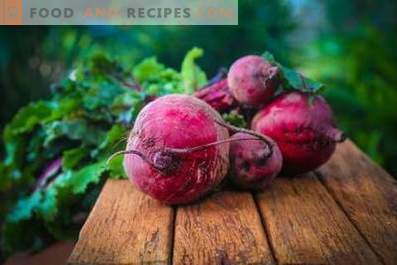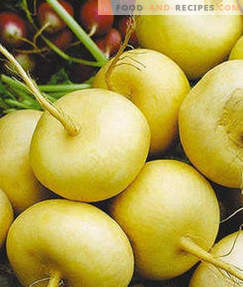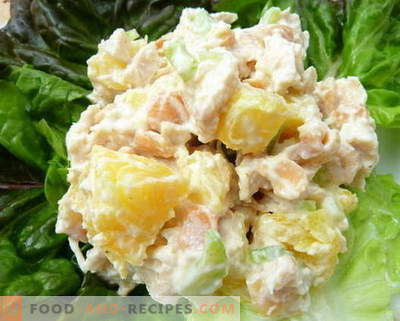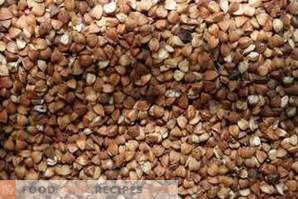
Carrot is a biennial plant of the Umbrella family. In the first year, it forms a root crop and a rosette of leaves, and the next season a seed bush and seeds are formed. Carrots are distributed almost everywhere, to the greatest extent - in the Mediterranean, African and Australian countries, in America and New Zealand. Manufacturers grow carrot seed. Carrot culture is distinguished as an independent species or a subspecies of wild carrots (Daucus sativus or Daucus carota subsp. Sativus). The cultivated plant is divided into table and fodder carrots.
The edible meaty root crop of a plant can vary in shape depending on the variety and can vary in color from orange and red to white and yellow. The most common form of carrots is an elongated cone or cylinder. The hard stem of the plant is covered with grooves and reaches a height of 30-100 cm. Triangular or elongated (up to 20 cm) oval leaves are repeatedly pinnatisect; the lower ones are strengthened on long petioles, and the upper ones are sessile. The complex umbrella of the inflorescence is formed by 10-15 rough-pubescent rays. During the flowering period, the inflorescence is revealed, and during fruiting, the rays are pressed together. Numerous leaves, located on the outside (wrapper), are tripartite or pinnate, and in shape resemble an awl or a narrow egg. Reddish or yellowish flowers have small teeth of the calyx, a notch and a segment curved inside it. The center of the inflorescence is marked with a flower with dark red petals. Small oval dvusemyanki reach a length of 3-4 mm. The semi-babies have 5 main linear ribs with two rows of folded setae and four secondary ribs with spikes. The secretory tubule is located under each secondary rib, and a pair of tubules is located on the commissure. The flowering of carrots occurs in the first year of plant life in June-July. Researchers report that wild carrots are found in a vast area from the Pacific coast to the Pyrenees. At the same time, cultural species can be found in the Himalayas. Academician N. I. Vavilov wrote that yellow and white carrots grow in the western Chinese lands. Botanists conclude that orange carrots come from the Mediterranean, and yellow and white from Afghanistan. But the fruits have long been known to mankind and are distributed almost everywhere (especially in temperate climates). Vegetable adapts perfectly to the harsh conditions of the Arctic Circle and at an altitude of more than three thousand meters in the mountains.
The history of the cultivation of orange fruit began more than 4 thousand years ago. Initially, carrots were used only for medicinal purposes, later the vegetable became food and feed. Archaeologists have discovered carrot seeds during excavations of buildings from the Neolithic period and the Bronze Age. In ancient Greece and the Roman Empire, the vegetable was called “Daucis” and “carote,” which is reflected in the modern names of the plant (English “carrot”). The Romans were very fond of the sweet root crop: in a culinary book of the period of the 3rd century BC. er Several recipes for carrots (salad, desserts) have been found, and in poetic collections one can find whole odes in honor of the fruitful fruit. The first plant researcher, Teofast, in his writings said that wild carrots were often used in medicine, which were colorless. The famous healer Hippocrates mentioned this vegetable in the list of medicinal herbs and fruits. In the book Dioskorida “About medical receptions” also found descriptions of the properties of carrots. Even in the Arab historical documents (for example, indicating the authorship of Ibn al-Awam) found information about the cultivation of red and yellow-green carrots. Sowing was carried out from late summer to early October, and cold climatic conditions along with irrigation favored the fact that carrots acquired a sweet taste. In ancient Russia, carrots were also known and popular in all classes. In the book about the family structure “Domostroy” (dated to the XVI century) it is noted that carrots were stocked for the winter along with turnips and beets. From the payroll books, it is clear that even the Upper Light and the royal family regularly ate carrots (it was often served fried or in a garlic sauce). At the beginning of the XVII century, the vegetable was already spread throughout Europe, which contributed to the breeding of the best food cultivars, including such as Carotel.
Food and vitamin value of carrots
First of all, carrots are known for their high content of carotene. It is from this component in the human body that vitamin A is produced. The vegetable is also rich in B vitamins, ascorbic acid, choline, phylloquinone. It was experimentally found that most of the vitamins in the fruits are collected before the first frost and have not lost their healing components.
Nutritional value 100 g carrots:
- 1, 312 g of proteins
- 0, 125 g of fats
- 7, 247 g of carbohydrates
- 0, 848 g of dietary fiber
- 0, 162 g of organic acids
- 89, 371 g of water
- 6, 734 g of monosaccharides and disaccharides
- 0, 264 g of starch
- 0, 792 g of ash
Vitamins per 100 g of carrots:
- 1, 183 mg beta-carotene (vitamin A provitamin)
- 183, 341 μg of retinol equivalent (A)
- 5, 162 mg of ascorbic acid (C)
- 0, 152 mg of thiamine (B1)
- 0, 027 mg of riboflavin (B2)
- 0, 342 mg of pantothenic acid (B5)
- 0, 184 mg of pyridoxine (B6)
- 9, 418 mkg of folic acid (B9)
- 1, 142 mg of vitamin PP
- 1, 231 mg of niacin equivalent (PP)
- 0, 637 mg of tocopherol (E)
- 0, 065 mcg of biotin (H)
- 13, 248 mcg of phylloquinone (K)
Energy value of carrots
Calorie carrots can be attributed to this vegetable to low-energy products. However, with additional heat treatment and adding oil, the energy value of the product varies greatly.
- Caloric value of 100 g of carrots is 33, 2 kcal.
- The caloric content of 1 medium-sized fruit (80 g) is equal to 26, 56 kcal.
- Calorie stewed carrots - 46 kcal without adding fat, 104 kcal while stewing with butter.
- The calorie content of boiled carrots is 26 kcal.
- Calories of fried carrots - 82 kcal (with olive oil).
When adding this vegetable to your diet, you should remember that boiled carrots are not suitable for those who are on a diet (despite the low calorie content). When cooking fiber carrots decompose into simple sugars that can harm the figure. In the frying process, carrots lose most of their beneficial properties.
Mineral composition of carrots
Carrots are very useful for the body due to the solid reserves of potassium, phosphorus, calcium and sodium. Due to this combination, the vegetable strengthens both the digestive and circulatory systems, as well as bones, teeth, hair. Other important elements (iron, magnesium, chlorine, sulfur) are present in the root crops, but in lower concentrations.
Macroelements in 100 g of carrots:
- 46, 263 mg of calcium (Ca)
- 234, 092 mg of potassium (K)
- 36, 528 mg of magnesium (Mg)
- 60, 504 mg of phosphorus (P)
- 65, 201 mg of sodium (Na)
- 63, 276 mg of chlorine (Cl)
- 6, 209 mg of sulfur (S)
Trace elements in 100 g of carrots:
- 1, 453 mg of iron (Fe)
- 0, 439 mg of zinc (Zn)
- 5, 176 mcg of iodine (I)
- 80, 283 mkg copper (Cu)
- 0, 285 mg of manganese (Mn)
- 3, 546 μg of chromium (Cr)
- 55, 498 μg of fluorine (F)
- 20, 352 μg of molybdenum (Mo)
- 200, 836 μg of boron (B)
- 99, 024 mcg of vanadium (V)
- 2, 572 µg cobalt (Co)
- 6, 957 mkg of lithium (Li)
- 323, 795 μg of aluminum (Al)
- 6, 825 µg of nickel (Ni)
Useful properties of carrots
- Beta-carotene present in root vegetables has a positive effect on lung function. In the process of assimilation, this component turns into vitamin A, useful to young women and those who suffer from visual impairment, night blindness, eye fatigue. The product strengthens the retina, optic nerves and eyeball.
- Vitamin A also helps keep mucous membranes healthy. For this reason, carrots and its juice are often used to treat beriberi, polyarthritis and disorders of the liver, heart, stomach. The state of colitis is facilitated by mashed boiled or raw carrots. For a more complete assimilation of provitamin A , it is recommended to add carrots with sour cream or sunflower oil.
- Ordinary raw carrots are very useful for gums. It not only promotes the growth of teeth and bones in children, but also reduces the number of bacteria in the oral cavity (thanks to volatile production of natural antibiotics).
- In boiled form, this vegetable is used to combat malignant tumors, nephritis and intestinal dysbiosis. Also, boiled carrots help with diabetes, as it is rich in simple sugars.
- The carrot with bright red skin is considered the most useful for cooking. Especially rich in vitamins are the fruits that were collected before the onset of the first frost.
- Carrot juice can be used as nasal drops for a cold.
- This root crop takes the second place (after cabbage) in the ability of to slow down the process of formation of fats. Raw carrots are often included in diets, but it is important to remember about the change in caloric content of the vegetable during heat treatment.
- The ratio of potassium and sodium salts in fruits is almost 10: 1. This factor and dietary fiber turn carrots into an effective diuretic and choleretic.
- Fresh carrot juice heals the skin with dermatitis and irritation, moisturizes it and evens out color.
- Root juice normalizes the functioning of the pancreas and other secretory systems. With possible disruption of any glands, carrot components actively restore their activity.
- It has been experimentally proved that carrot juice improves the condition in case of cancer. Clinical trials have revealed that the components of the juice strengthen healthy cells and inhibit the formation of tumors. It is important to remember that it is fresh juice that is suitable for such treatment, and sugar and starch, not digestible carbohydrates, should be combined with it.
- Fruit juice is known for its ability to strengthen the immune system and the nervous system. This drink includes not only in medical, but also preventive diets.
- Juice squeezed from carrots is a natural remedy for cleaning the body from accumulated slags. The entire excretory system remains healthy and works much more efficiently if a person regularly includes this vegetable and its juice in food.
- Pregnant women drink carrot juice so that the baby receives enough mineral elements. For the same reason, nursing women increase the biological usefulness of breast milk by adding carrots to their diets. This procedure leads to a noticeable strengthening of the baby’s immune system.
- Carrot juice relieves fatigue and increases appetite. It is very useful to take vegetable juice when using antibiotics, since this reduces their toxic effects on the body.
Contraindications to the use of carrots
- Carrots should not be included in the diet during an exacerbation of a stomach ulcer, small intestine, or inflammation of their mucous membranes.
- It is important to carefully monitor your condition when you first eat carrots. If the palms become orange-yellow after eating this product, the amount of carrots in the diet should be reduced.
- Overeating of this fetus may cause drowsiness, lethargy, nausea, and fatigue.
- Individual intolerance to carrots is an indisputable argument against the use of vegetables.
- The daily rate of carrots is no more than 300 g, which corresponds to 3-4 medium-sized fruits.











































